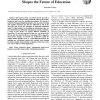Free Online Productivity Tools
i2Speak
i2Symbol
i2OCR
iTex2Img
iWeb2Print
iWeb2Shot
i2Type
iPdf2Split
iPdf2Merge
i2Bopomofo
i2Arabic
i2Style
i2Image
i2PDF
iLatex2Rtf
Sci2ools
IJVR
2008
2008
How and Why Affordable Virtual Reality Shapes the Future of Education
This paper presents an analysis of how and why a new generation of virtual reality peripherals affect virtual reality in general, and its uses for education in particular. We describe a method to bring psychological principles, such as positive learning and cognitive dynamics into the best utilization of VR in the classroom and present the technique of emotional modulation aimed to help students in absorbing the information they are presented with more efficiently. Edutainment is made available by a range of new devices to support different modalities of interaction. We present taxonomy of low-cost, yet advanced IO devices and show how the future of education will be shaped by these factors. Finally, we describe an architecture called the Virtual Human Interface used as a generalized framework for building new educational content and conclude with showing practical examples and psychiatric evaluation of how our system was used to address real-life applications.
| Added | 12 Dec 2010 |
| Updated | 12 Dec 2010 |
| Type | Journal |
| Year | 2008 |
| Where | IJVR |
| Authors | Barnabas Takacs |
Comments (0)

